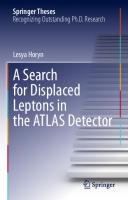Supersymmetric Beasts and Where to Find Them: From Novel Hadronic Reconstruction Methods to Search Results in Large Jet Multiplicity Final States at the ATLAS Experiment (Springer Theses) 9783030940461, 9783030940478, 3030940462
After an extensive overview of the Standard Model and of the theory and phenomenology of Supersymmetry, this book descri
135 28 10MB
English Pages 237 [231]
Table of contents :
Supervisor’s Foreword
Abstract
Acknowledgments
Contents
1 Introduction
Reference
Part I General Overview: From Theory and Phenomenology to Event Reconstruction at the Atlas Experiment
2 The Standard Model of Particle Physics
2.1 Quantum Chromodynamics
2.2 Electroweak Unification
2.2.1 Charged Interactions
2.2.2 Neutral Interactions
2.2.3 Gauge Bosons Self-Interactions
2.3 The Higgs Mechanism
2.3.1 Masses of Vector Bosons
2.3.2 Masses of Fermions
2.4 Open Problems and Questions of the Standard Model
2.5 Conclusion
References
3 Supersymmetry
3.1 The Minimal Supersymmetric Standard Model
3.1.1 Superfields, Superspace and SUSY Invariant Lagrangians
3.1.2 MSSM Superpotential
3.1.3 R-Parity
3.1.4 Soft Supersymmetry Breaking
3.1.5 Charginos and Neutralinos
3.2 SUSY Phenomenology at the LHC
3.2.1 SUSY Production at the LHC
3.2.2 Decays of SUSY Particles
3.2.3 R-Parity Violation
3.3 Conclusion
References
4 The ATLAS Detector at the Large Hadron Collider
4.1 The Large Hadron Collider
4.1.1 Pileup at the LHC
4.2 The ATLAS Experiment
4.2.1 Detector Coordinate System
4.2.2 The Inner Detector
4.2.3 Calorimeters
4.2.4 Muon Spectrometer
4.2.5 The Trigger and Data Acquisition System
4.3 Conclusion
References
5 ATLAS Object Reconstruction
5.1 Track and Vertex Reconstruction
5.2 Jet Reconstruction
5.2.1 Jet Constituents and Calorimeter Topoclusters
5.2.2 Jet Building: The Anti-kt Algorithm
5.2.3 Jet Calibrations
5.2.4 Pileup Jet Identification
5.3 Flavour Tagging
5.4 Electron and Photon Reconstruction
5.4.1 Electron and Photon Calibration
5.4.2 Electron Identification
5.5 Muon Reconstruction
5.5.1 Muon Calibration
5.5.2 Muon Identification
5.6 Missing Transverse Momentum
5.7 Conclusion
References
Part II Hadronic Event Reconstruction, Performance and Pileup Suppression
6 Performance of Missing Transverse Momentum
6.1 ETmiss Reconstruction
6.1.1 The ETmiss Soft Term
6.2 Overlap Removal Treatment
6.3 ETmiss Working Points
6.4 ETmiss Performance
6.5 The Track-Based Soft Term Systematics
6.6 Object-Based ETmiss Significance
6.7 Conclusion
References
7 Particle Flow Reconstruction
7.1 The ATLAS Particle Flow Algorithm
7.1.1 Track Selection
7.1.2 Track-to-Topocluster Matching
7.1.3 Energy Subtraction
7.1.4 Remnant Removal
7.2 Particle Flow Jet and ETmiss Performance
7.2.1 Particle Flow Jets
7.2.2 Particle Flow ETmiss
7.3 Conclusion and Future Prospects
References
8 Constituent Pileup Suppression Techniques
8.1 Overview of Current Constituent Pileup Mitigation Techniques
8.1.1 Soft Killer
8.1.2 Cluster Timing Cleaning
8.2 Multivariate Neutral Pileup Suppression
8.2.1 Boosted Decision Trees
8.2.2 Input Variables and Hard-Scatter Cluster Definition
8.2.3 Training and Performance
8.2.4 Impact on ETmiss Reconstruction
8.3 Conclusion
References
9 Hadronic Trigger Reconstruction for the HL-LHC
9.1 HL-LHC Detector Upgrades
9.1.1 The Inner Tracker
9.2 The Phase-II ATLAS TDAQ Upgrade
9.2.1 Level-0 Trigger
9.2.2 Event Filter and Hardware Track Trigger (HTT)
9.3 Jet and ETmiss Trigger Reconstruction at the HL-LHC
9.3.1 Reconstruction at the Global Trigger
9.3.2 Reconstruction at the Event Filter
9.4 Impact of HTT on Jet and ETmiss Triggers
9.5 Further Ideas and Improvements
9.6 Conclusion
References
Part III The Hunt for New Phenomena in Signatures with Large Jet Multiplicities
10 Hunting New Physics in Multi-jet Final States
10.1 Analysis Overview
10.2 Signal Models
10.2.1 Phenomenological MSSM Slice
10.2.2 Two-Step Gluino Decay Model
10.2.3 The `Gtt' Model
10.2.4 The `RPV' Model
10.3 Backgrounds
10.3.1 Leptonic Backgrounds
10.3.2 Multi-jet Background
10.4 Analysis Definition
10.4.1 Triggers
10.4.2 Physics Object Definition
10.4.3 Kinematic Variable Definitions
10.4.4 Event Cleaning
10.4.5 Event Selection
10.5 Optimization Studies
10.6 Background Estimation
10.6.1 Leptonic Backgrounds
10.6.2 Multi-jet Background
10.7 Systematic Uncertainties
10.7.1 Experimental Uncertainties
10.7.2 Template Uncertainties
10.7.3 Theoretical Uncertainties
References
11 Results and Interpretations of the SUSY Multi-jet Search
11.1 Statistical Analysis
11.1.1 Probability Density Functions (PDFs)
11.1.2 Nuisance Parameters and Systematics
11.2 Background-Only Fit
11.2.1 Multi-bin Fit
11.2.2 Single-Bin Fit
11.3 Statistical Tests and Model-Independent Fit
11.3.1 Discovery Test and Model-Independent Fit
11.4 Exclusion Limits on RPC Models
11.5 Exclusion Limits on RPV Models
11.5.1 RPV Signals
11.5.2 Results
11.6 Impact of Particle Flow
11.7 Comparisons with Other Searches
11.8 New Signatures for Flavoured Dark Matter Models
References
12 Conclusions and Outlook
Appendix Additional Elements of Theory
A.1 Group Theory and Symmetries
A.2 Yang-Mills Theories
A.2.1 Quantum Electrodynamics (QED)
A.2.2 Non-abelian Yang-Mills Theories
A.3 The Wess-Zumino Model
Reference
Supervisor’s Foreword
Abstract
Acknowledgments
Contents
1 Introduction
Reference
Part I General Overview: From Theory and Phenomenology to Event Reconstruction at the Atlas Experiment
2 The Standard Model of Particle Physics
2.1 Quantum Chromodynamics
2.2 Electroweak Unification
2.2.1 Charged Interactions
2.2.2 Neutral Interactions
2.2.3 Gauge Bosons Self-Interactions
2.3 The Higgs Mechanism
2.3.1 Masses of Vector Bosons
2.3.2 Masses of Fermions
2.4 Open Problems and Questions of the Standard Model
2.5 Conclusion
References
3 Supersymmetry
3.1 The Minimal Supersymmetric Standard Model
3.1.1 Superfields, Superspace and SUSY Invariant Lagrangians
3.1.2 MSSM Superpotential
3.1.3 R-Parity
3.1.4 Soft Supersymmetry Breaking
3.1.5 Charginos and Neutralinos
3.2 SUSY Phenomenology at the LHC
3.2.1 SUSY Production at the LHC
3.2.2 Decays of SUSY Particles
3.2.3 R-Parity Violation
3.3 Conclusion
References
4 The ATLAS Detector at the Large Hadron Collider
4.1 The Large Hadron Collider
4.1.1 Pileup at the LHC
4.2 The ATLAS Experiment
4.2.1 Detector Coordinate System
4.2.2 The Inner Detector
4.2.3 Calorimeters
4.2.4 Muon Spectrometer
4.2.5 The Trigger and Data Acquisition System
4.3 Conclusion
References
5 ATLAS Object Reconstruction
5.1 Track and Vertex Reconstruction
5.2 Jet Reconstruction
5.2.1 Jet Constituents and Calorimeter Topoclusters
5.2.2 Jet Building: The Anti-kt Algorithm
5.2.3 Jet Calibrations
5.2.4 Pileup Jet Identification
5.3 Flavour Tagging
5.4 Electron and Photon Reconstruction
5.4.1 Electron and Photon Calibration
5.4.2 Electron Identification
5.5 Muon Reconstruction
5.5.1 Muon Calibration
5.5.2 Muon Identification
5.6 Missing Transverse Momentum
5.7 Conclusion
References
Part II Hadronic Event Reconstruction, Performance and Pileup Suppression
6 Performance of Missing Transverse Momentum
6.1 ETmiss Reconstruction
6.1.1 The ETmiss Soft Term
6.2 Overlap Removal Treatment
6.3 ETmiss Working Points
6.4 ETmiss Performance
6.5 The Track-Based Soft Term Systematics
6.6 Object-Based ETmiss Significance
6.7 Conclusion
References
7 Particle Flow Reconstruction
7.1 The ATLAS Particle Flow Algorithm
7.1.1 Track Selection
7.1.2 Track-to-Topocluster Matching
7.1.3 Energy Subtraction
7.1.4 Remnant Removal
7.2 Particle Flow Jet and ETmiss Performance
7.2.1 Particle Flow Jets
7.2.2 Particle Flow ETmiss
7.3 Conclusion and Future Prospects
References
8 Constituent Pileup Suppression Techniques
8.1 Overview of Current Constituent Pileup Mitigation Techniques
8.1.1 Soft Killer
8.1.2 Cluster Timing Cleaning
8.2 Multivariate Neutral Pileup Suppression
8.2.1 Boosted Decision Trees
8.2.2 Input Variables and Hard-Scatter Cluster Definition
8.2.3 Training and Performance
8.2.4 Impact on ETmiss Reconstruction
8.3 Conclusion
References
9 Hadronic Trigger Reconstruction for the HL-LHC
9.1 HL-LHC Detector Upgrades
9.1.1 The Inner Tracker
9.2 The Phase-II ATLAS TDAQ Upgrade
9.2.1 Level-0 Trigger
9.2.2 Event Filter and Hardware Track Trigger (HTT)
9.3 Jet and ETmiss Trigger Reconstruction at the HL-LHC
9.3.1 Reconstruction at the Global Trigger
9.3.2 Reconstruction at the Event Filter
9.4 Impact of HTT on Jet and ETmiss Triggers
9.5 Further Ideas and Improvements
9.6 Conclusion
References
Part III The Hunt for New Phenomena in Signatures with Large Jet Multiplicities
10 Hunting New Physics in Multi-jet Final States
10.1 Analysis Overview
10.2 Signal Models
10.2.1 Phenomenological MSSM Slice
10.2.2 Two-Step Gluino Decay Model
10.2.3 The `Gtt' Model
10.2.4 The `RPV' Model
10.3 Backgrounds
10.3.1 Leptonic Backgrounds
10.3.2 Multi-jet Background
10.4 Analysis Definition
10.4.1 Triggers
10.4.2 Physics Object Definition
10.4.3 Kinematic Variable Definitions
10.4.4 Event Cleaning
10.4.5 Event Selection
10.5 Optimization Studies
10.6 Background Estimation
10.6.1 Leptonic Backgrounds
10.6.2 Multi-jet Background
10.7 Systematic Uncertainties
10.7.1 Experimental Uncertainties
10.7.2 Template Uncertainties
10.7.3 Theoretical Uncertainties
References
11 Results and Interpretations of the SUSY Multi-jet Search
11.1 Statistical Analysis
11.1.1 Probability Density Functions (PDFs)
11.1.2 Nuisance Parameters and Systematics
11.2 Background-Only Fit
11.2.1 Multi-bin Fit
11.2.2 Single-Bin Fit
11.3 Statistical Tests and Model-Independent Fit
11.3.1 Discovery Test and Model-Independent Fit
11.4 Exclusion Limits on RPC Models
11.5 Exclusion Limits on RPV Models
11.5.1 RPV Signals
11.5.2 Results
11.6 Impact of Particle Flow
11.7 Comparisons with Other Searches
11.8 New Signatures for Flavoured Dark Matter Models
References
12 Conclusions and Outlook
Appendix Additional Elements of Theory
A.1 Group Theory and Symmetries
A.2 Yang-Mills Theories
A.2.1 Quantum Electrodynamics (QED)
A.2.2 Non-abelian Yang-Mills Theories
A.3 The Wess-Zumino Model
Reference

- Author / Uploaded
- Marco Valente





![The Read-Out Controller ASIC for the ATLAS Experiment at LHC (Springer Theses) [1st ed. 2022]
9783031180736, 9783031180743, 3031180739](https://ebin.pub/img/200x200/the-read-out-controller-asic-for-the-atlas-experiment-at-lhc-springer-theses-1st-ed-2022-9783031180736-9783031180743-3031180739.jpg)

